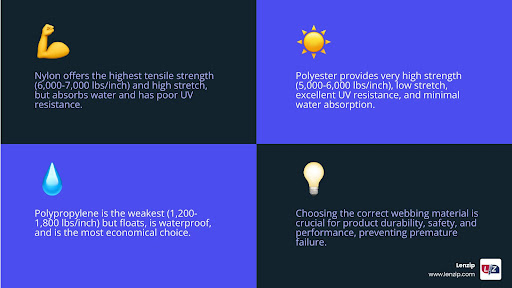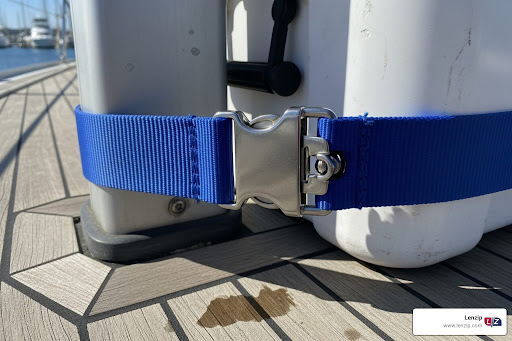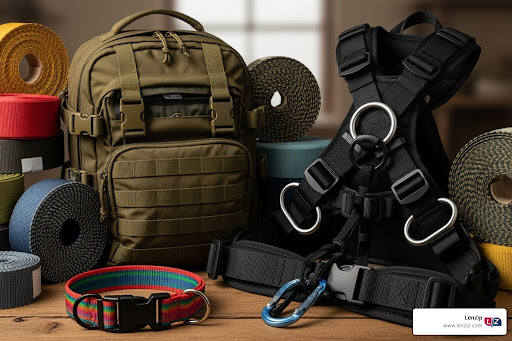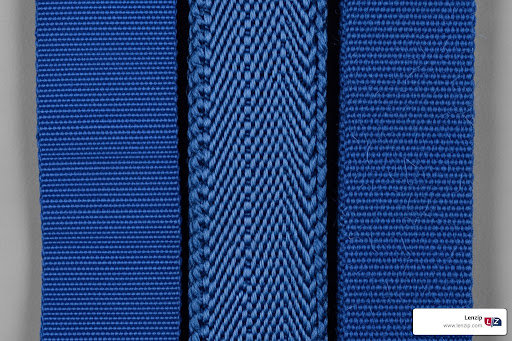The choice between nylon, polyester, and polypropylene webbing may seem small—but for manufacturers and designers, it can define the difference between a reliable, long-lasting product and one that fails under pressure. Whether you’re building industrial safety harnesses, marine covers, or outdoor gear, your webbing material determines the product’s strength, stability, and safety.
At LenZip, we’ve spent more than 75 years helping OEMs, fabricators, and engineers select the perfect materials for real-world performance. Through continuous testing under ASTM and NFPA standards, we know how each fiber behaves under stress, sunlight, moisture, and time. This guide explores how these three core materials perform head-to-head—and which one will help you deliver the durability your customers expect.

The Importance of Choosing the Right Webbing
Webbing is the hidden workhorse of thousands of industrial and consumer products. You’ll find it reinforcing seat belts, cargo straps, boat covers, and protective gear. Because it bears tension and friction daily, material choice is not just about looks—it’s about safety, longevity, and compliance.
Selecting the wrong webbing can lead to stretched-out straps, UV damage, or chemical degradation—each one a recipe for early product failure and costly warranty claims. For this reason, every LenZip-engineered component—from custom zippers to webbing assemblies—is built with precise attention to tensile strength, environmental exposure, and lifecycle cost.
So, which material is truly superior? Let’s break it down.
Quick Comparison
| Property | Nylon Webbing | Polyester Webbing | Polypropylene Webbing |
|---|---|---|---|
| Tensile Strength | 6,000–7,000 lbs/inch | 5,000–6,000 lbs/inch | 1,200–1,800 lbs/inch |
| Stretch (Elongation) | 20–30% | 5–10% | Low–Medium |
| Water Absorption | 4–10% | <1% | <0.01% (floats) |
| UV Resistance | Poor | Excellent | Moderate |
| Abrasion Resistance | Excellent | Very High | Low |
| Melting Point | ~300°F (149°C) | ~257°F (125°C) | ~300°F (softens earlier) |
For more details on material specifications, explore Polypropylene vs Polyester or Nylon vs Polypropylene for Marine and More.

Strength, Stretch, and Durability
When it comes to raw power, nylon webbing leads the pack. With tensile strength reaching up to 7,000 pounds per inch, it’s the undisputed choice for safety harnesses, fall-protection systems, towing straps, and climbing equipment. What makes nylon unique is its “snap-back” elasticity—it stretches under load (20–30%) but rebounds to its original length, reducing sudden impact forces that could otherwise damage components or injure users.
However, raw strength doesn’t tell the full story. Polyester webbing, while slightly less powerful, offers exceptional dimensional stability. With only 5–10% stretch under load, polyester holds its shape, making it ideal for cargo tie-downs, seat belts, and marine applications where precision tensioning is essential. Its low elongation helps products maintain structural integrity even after years of use.
Polypropylene webbing, though lighter and less robust, offers key advantages in buoyancy, flexibility, and cost-efficiency. While its tensile strength ranges between 1,200–1,800 lbs/inch, it’s more than adequate for lightweight products such as flotation devices, utility straps, and poolside furniture.
At LenZip, we’ve tested each fiber extensively to ensure OEMs get the best material match for their performance goals. Learn more about our in-house standards in Zipper Testing Standards.
Environmental and Chemical Resistance
Environmental stressors are often the true test of webbing performance. UV exposure, moisture, temperature shifts, and chemicals all determine long-term reliability.

Nylon, despite its strength, struggles in wet or humid environments. It absorbs 4–10% of its weight in water, which reduces tensile strength by up to 15%. That’s why nylon webbing, while excellent for safety or load-bearing gear, isn’t the best fit for marine or outdoor use.
Polyester, in contrast, shines under those same conditions. It absorbs less than 1% of its weight in moisture and maintains 95% of its dry strength when wet. Its UV stability is the best of the three—it resists fading, brittleness, and photodegradation even after thousands of hours in sunlight. This makes polyester the leading choice for boat covers, hammocks, awnings, and industrial enclosures that must perform through years of outdoor exposure.
Polypropylene, on the other hand, is virtually waterproof and even floats, making it a favorite in marine, pool, and watercraft applications. However, it degrades faster than polyester under long-term UV exposure unless stabilized with additives or coatings.
When chemical exposure comes into play, polypropylene once again takes the lead. It resists acids, oils, and solvents better than both nylon and polyester, making it a smart pick for chemical-handling straps and industrial tie-downs.
For detailed insight on fiber coatings and corrosion resistance, see Zipper Materials & Finishes.
Temperature, Flexibility, and Feel
Performance also depends on how webbing behaves under temperature and touch.
All three materials handle moderate heat—between 257°F and 300°F—but polypropylene softens sooner under continuous sun or tension. Nylon retains flexibility even in cold conditions and feels soft, smooth, and skin-friendly, which is why it’s often used for backpack straps, safety gear, and pet leashes.
Polyester has a slightly firmer texture with a low-sheen finish, giving it a professional look ideal for automotive interiors, seat belts, and marine enclosures. Polypropylene feels waxy and more industrial, suited to utility applications where comfort is less critical.
Learn how different polymers behave under heat and tension in Unraveling the Differences: Nylon and Polyester Explained.
Applications Across Industries
Every industry uses webbing differently, and understanding those distinctions helps ensure proper material choice:
Nylon – The High-Strength Workhorse
Trusted in climbing harnesses, fall arrest systems, tow straps, and military gear, nylon’s combination of tensile strength and flexibility provides superior energy absorption and reliability where performance equals safety.Polyester – The Outdoor Champion
From boat covers and seat belts to cargo restraints and outdoor furniture, polyester’s UV resistance, minimal stretch, and long-term durability make it the top performer for sun and moisture exposure.Polypropylene – The Lightweight Contender
Used for flotation devices, battery tie-downs, pool furniture, and low-cost gear straps, polypropylene’s waterproof, chemical-resistant properties make it unbeatable in value-driven projects.
To see how material selection integrates with fastening systems, visit Resources and explore how LenZip supports OEM design optimization through customized testing and prototyping.

Cost, Longevity, and Performance Value
Price differences among these materials are notable but often misleading. Polypropylene has the lowest cost per yard but wears out faster under UV and mechanical stress. Polyester sits comfortably in the middle—costing a bit more but delivering far superior long-term durability and color stability. Nylon, though the most expensive, remains indispensable in applications where human safety depends on tensile strength and controlled stretch.
Experienced manufacturers understand that the true cost lies not in initial purchase price but in lifecycle value—durability, warranty exposure, and customer satisfaction. A product that fails prematurely due to material fatigue can wipe out savings many times over.
For example, switching from polypropylene to polyester webbing may raise material costs slightly, but can extend product lifespan by two to three times in outdoor use, reducing replacement cycles and customer complaints.
At LenZip, we emphasize this total-performance approach—because the right material doesn’t just last longer; it protects your reputation.
Color Retention, Dyeing, and Identification
Color stability matters more than aesthetics—it signals durability.

Polyester offers unmatched colorfastness, holding its vibrancy even after 1,000+ hours of UV exposure. Nylon, while highly dyeable, fades quickly under sunlight. Polypropylene resists staining but limits color options due to its non-polar molecular structure.
To identify webbing types: polypropylene floats in water; nylon and polyester sink. Nylon stretches more when wet, while polyester stays firm and dries faster.
For more on polymer testing and terminology, see Webbing Terminology and Zipper Glossary.
Making the Right Choice
The best material depends entirely on your environment and end use:
Nylon delivers ultimate tensile strength and elasticity for safety, climbing, and impact applications.
Polyester provides the most stable, UV-resistant solution for marine and outdoor exposure.
Polypropylene offers low-cost, waterproof functionality for recreational or industrial products.
At LenZip, we combine decades of engineering with in-house material testing to help clients choose with confidence. Whether designing industrial covers, marine enclosures, or custom fastening systems, our team ensures every fiber aligns with your performance goals.
Request a quote today at lenzip.com/request-a-quote to build smarter, safer, and longer-lasting products.
Conclusion: Engineered for Performance and Reliability
Choosing between nylon, polyester, and polypropylene webbing is more than a technical decision—it’s an investment in your product’s future. Nylon leads in raw power, polyester dominates durability and UV resistance, and polypropylene excels in cost efficiency and waterproofing.
When you partner with LenZip, you’re not just sourcing materials—you’re gaining access to U.S.-made quality, traceable production, and engineering expertise that’s been trusted for over 75 years. From industrial zippers to performance-tested webbing, every component we build meets strict ASTM, NFPA, and MIL-SPEC standards for long-term performance.
Visit our Resources Library, or learn why OEMs continue to choose LenZip for precision, reliability, and American manufacturing excellence.
FAQ: Nylon vs Polyester vs Polypropylene Webbing
Which webbing is the strongest?
Nylon webbing tops the chart with up to 7,000 lbs per inch of tensile strength, making it ideal for high-stress and safety-critical applications.
Which webbing performs best outdoors?
Polyester maintains over 95% of its strength when wet and resists UV degradation, making it the most reliable choice for marine and outdoor gear.
Which webbing is most waterproof?
Polypropylene is nearly waterproof and even floats, perfect for marine, poolside, and flotation products.
Which offers the best long-term value?
Polyester offers the ideal balance of cost, strength, and weather resistance for most industrial and consumer products.
Where can I find U.S.-made webbing solutions?
Visit LenZip to explore American-made webbing and zipper systems designed for industrial, marine, and performance applications.
